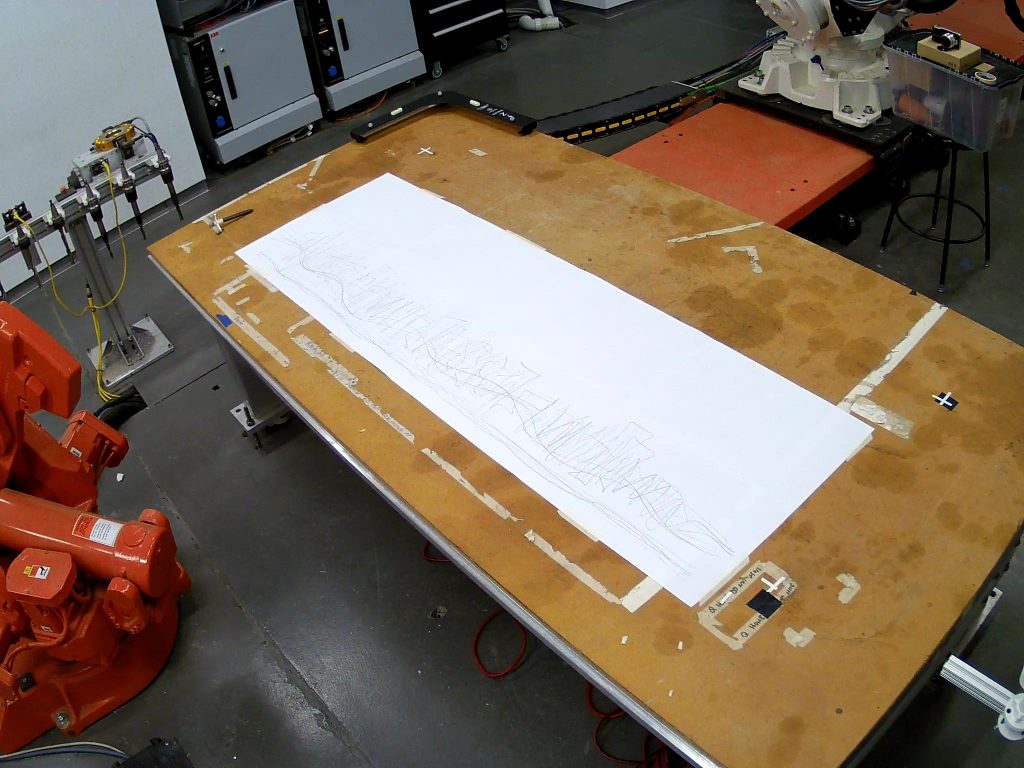Gesture Drawing Analysis
Stephanie Smid, Jett Vaultz
Feb. 18, 2018
https://vimeo.com/256356880
ABSTRACT
Drawing machines typically rely on constant pressure, use pressure for line thickness, or have no varying thickness at all. In freehand gesture drawing, an artist uses much more than just pressure to create varying lineweights. Tools such as pencils that have a variety of contact points with the paper afford an artist multiple angles with which to draw. Taking this as a starting point, is it possible to use motion capture to analyze how a skilled artist uses angles to produce dynamic lineweights?
OBJECTIVES
From a technical standpoint, our main goal was to use this project as a way to become familiar with the motion capture system, from capturing raw data to understanding ways in which to analyze it. We also hoped to boost our knowledge of Grasshopper and Python. In regards to studying an expert’s gestural drawing, our main goals were:
To Observe:
- how our expert makes use of a drawing tool’s unique affordances,
- varies their drawing style based on line types,
- and instinctively holds and angles a drawing tool in such a way as to produce various lineweights
And to Analyze:
- drawing data in an attempt to quantify an expert’s movements,
- correlations between the pencil’s tilt and the line thickness,
- and explore if a standard range of motion can be seen throughout various line types
IMPLEMENTATION
The pencil we chose had the unique property of being only graphite, meaning its possible range of contact points with the paper was much greater than that of a regular pencil. We hoped the affordance given by this tool would encourage our expert to explore a larger range of pencil orientations. To be able to accurately capture our expert’s drawing skills we had to create a rigid body marker set for our graphite pencil. We chose to 3D print the mocap marker holder in order to keep the weight of the holder as light as possible, as we didn’t want a top-heavy tool to potentially bias our artist’s positioning of the pencil. 3D printing also allowed us to make a very strong friction-fit connection between the pencil and the marker holder.

The expert who graciously agreed to draw for us was Rebecca Lefkowitz, a first-year Urban Design graduate student in the School of Architecture. In order to control our data, we studied two simple drawing exercises with two sub-categories for each:
- A Straight Line
- a thin straight line with as little line thickness variation as possible
- a varied straight line with fluctuation in line thickness
- A Curved Line
- a thin curved line with as little line thickness variation as possible
- a varied curved line with fluctuation in line thickness

Through limiting the drawings to simple, basic shapes, this allowed Rebecca to focus more on the quality of her lines rather than the overall effect of the drawing. After obtaining the motion capture data we went into Grasshopper and began analyzing the four line types based on the pencil’s tilt and rotation. The tilt analyzes how far Rebecca angles her pencil off of a completely vertical pencil orientation. The rotation analyzes the direction in which Rebecca holds the pencil in regards to the path of travel for the line being drawn.
OUTCOMES

Once getting into Grasshopper, we initially had a hard time getting our capture data to parse correctly. After circumventing some bugs we were able to develop a definition that allowed us to quantify the tilt and rotation of Rebecca’s lines. While we already expected for higher tilt angles to produce thicker lineweights, what we found surprising was the variety of combinations where similar tilt angles were used with different rotation values. Moreso, after watching our analysis animation data, we found that even between different line types Rebecca tended to stay within a specific zone of values. To show this, the image below shows Rebecca’s “zone cone” when using the graphite pencil:

With future testing, it would be interesting to see how different artists’ “zone cones” vary based on personal styles. The zone will also change depending on the specific drawing tool used. This project could allow for manipulations of this cone in a way that could reshape the tip of the drawing tool itself, rather than the zone resulting from the tip. For even further development, our analysis could provide new techniques for end effectors that would allow drawing machines to move away from pressure-reliant systems and integrate tilt and rotation into the creation of more dynamic lineweights and complex drawings.
CONTRIBUTION
Stephanie: provided the mocap creation, analysis methods, Grasshopper definition, and blog post
Jett: provided the graphite pencil, mocap creation, analysis methods, Python scripting, and video editing/post processing